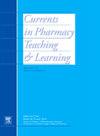Exploring the effect of peer assessment on final exam scores and pharmacy students' perspectives towards peer assessment in laboratory practice
IF 1.4
Q3 EDUCATION, SCIENTIFIC DISCIPLINES
引用次数: 0
Abstract
Introduction
Practical sessions of the Biopharmaceutics and Pharmacokinetics course (BF) in the Faculty of Pharmacy, Universitas Andalas, Indonesia, were a mandatory group-based learning experience aimed at fostering cooperative and collaborative attitudes. This research aims to explore the impact of peer group assessment on final exam scores and investigate students' perceptions of the impact of peer assessment on attitudes within groups during the course.
Methods
This cross-sectional study was conducted during the odd semester, involving 3rd year pharmacy undergraduate students at Faculty of Pharmacy of Universitas Andalas. Students in the same group were grading their peers by participation percentages. At the end of the semester, the participation percentage was compared with the final test score (excellent, good, satisfactory) and analyzed using ANOVA. The perspectives of students about peer assessment on student groups were surveyed using 5-point Likert scale.
Results
The p-values of ANOVA between the three groups of final exam score and participation percentage were 0.219. Some students expressed satisfaction with peer assessment as they see it can influence students' motivation and contribution to the overall learning experience in the BF practical course.
Conclusion
The results of the ANOVA between the three groups of final exam scores and participation percentage indicate that peer assessment through participation percentage did not influence the final exam result. However, the distribution of participation percentage and perspective of students showed that peer assessment can serve as an effective tool in enhancing pharmacy students' engagement during group-based practical sessions.
探讨同行评议对期末考试成绩的影响及药学学生在实验室实践中对同行评议的看法
印度尼西亚安达拉大学药学院生物制药和药代动力学课程(BF)的实践环节是一项强制性的以小组为基础的学习经验,旨在培养合作和协作的态度。本研究旨在探讨同侪小组评估对期末考试成绩的影响,并调查学生在课程中对同侪小组评估对小组内态度影响的看法。方法采用单学期横断面研究方法,选取安得拉斯大学药学院药学三年级本科生为研究对象。同一组的学生根据参与百分比给同学打分。在学期结束时,将参与百分比与期末考试成绩(优秀,良好,满意)进行比较,并使用方差分析进行分析。采用5点李克特量表调查学生对学生群体同伴评价的看法。结果三组学生期末考试成绩与参与率的方差分析p值均为0.219。一些学生对同伴评估表示满意,因为他们认为这可以影响学生的动机,并对BF实践课程的整体学习体验做出贡献。结论三组期末考试成绩与参与百分比的方差分析结果表明,通过参与百分比进行同伴评价对期末考试成绩没有影响。然而,学生的参与百分比和观点的分布表明,同行评估可以作为一种有效的工具,提高药学学生在小组实践课程中的参与度。
本文章由计算机程序翻译,如有差异,请以英文原文为准。
求助全文
约1分钟内获得全文
求助全文
来源期刊

Currents in Pharmacy Teaching and Learning
EDUCATION, SCIENTIFIC DISCIPLINES-
CiteScore
2.10
自引率
16.70%
发文量
192
 求助内容:
求助内容: 应助结果提醒方式:
应助结果提醒方式:


